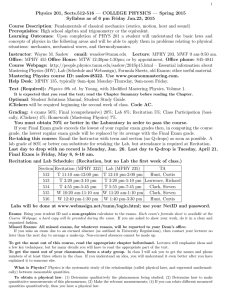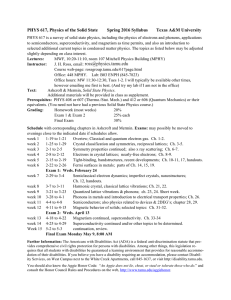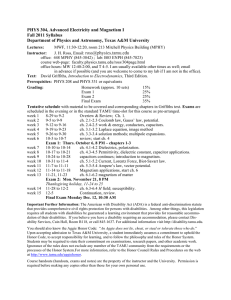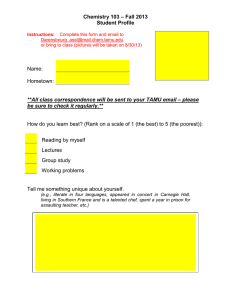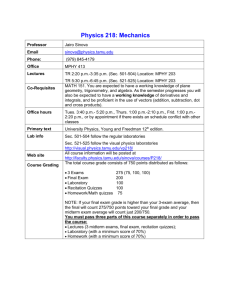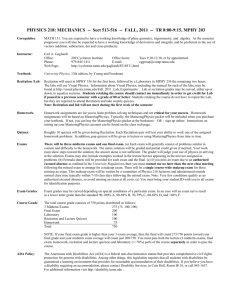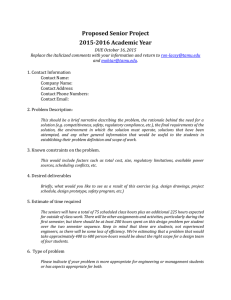PHYS 201 College Physics Summer 2015 MWF 10:00
advertisement
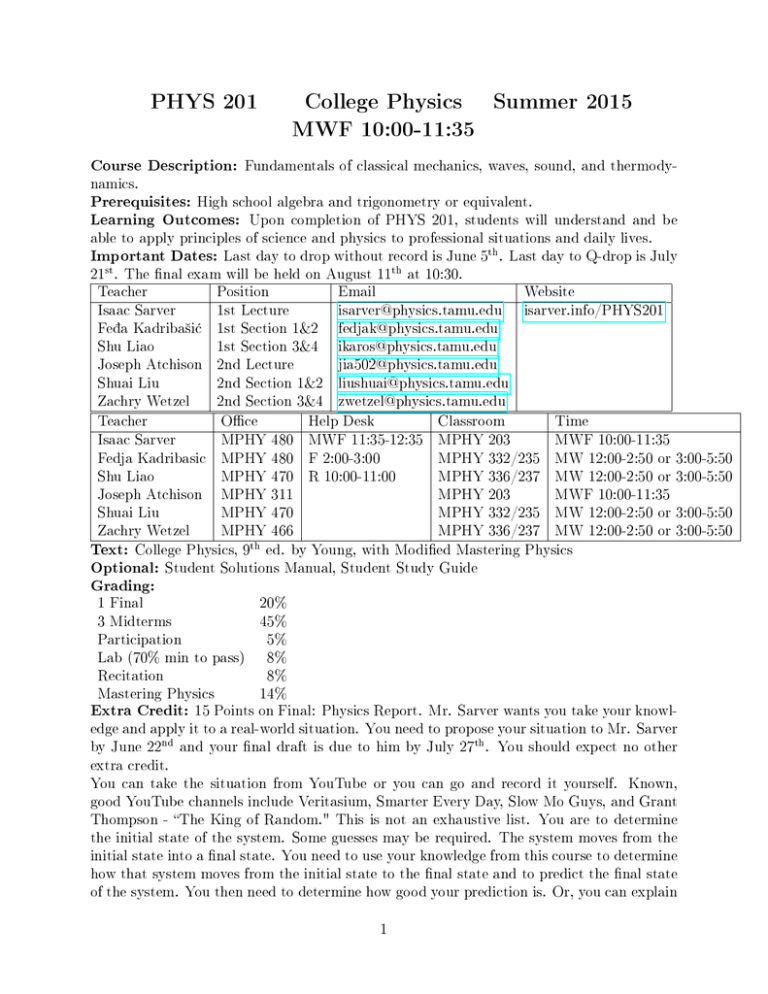
PHYS 201 College Physics Summer 2015 MWF 10:00-11:35 Course Description: Fundamentals of classical mechanics, waves, sound, and thermody- namics. Prerequisites: High school algebra and trigonometry or Learning Outcomes: Upon completion of PHYS 201, equivalent. students will understand and be able to apply principles of science and physics to professional situations and daily lives. Important Dates: st th . Last day to Q-drop is July Last day to drop without record is June 5 21 . The nal exam will be held on August 11 th at 10:30. Teacher Position Email Website Isaac Sarver 1st Lecture isarver@physics.tamu.edu isarver.info/PHYS201 Fea Kadriba²i¢ 1st Section 1&2 fedjak@physics.tamu.edu Shu Liao 1st Section 3&4 ikaros@physics.tamu.edu Joseph Atchison 2nd Lecture jia502@physics.tamu.edu Shuai Liu 2nd Section 1&2 liushuai@physics.tamu.edu Zachry Wetzel 2nd Section 3&4 zwetzel@physics.tamu.edu Teacher Oce Help Desk Classroom Time Isaac Sarver MPHY 480 MWF 11:35-12:35 MPHY 203 MWF 10:00-11:35 Fedja Kadribasic MPHY 480 F 2:00-3:00 MPHY 332/235 MW 12:00-2:50 or 3:00-5:50 Shu Liao MPHY 470 R 10:00-11:00 MPHY 336/237 MW 12:00-2:50 or 3:00-5:50 Joseph Atchison MPHY 311 MPHY 203 MWF 10:00-11:35 Shuai Liu MPHY 470 MPHY 332/235 MW 12:00-2:50 or 3:00-5:50 Zachry Wetzel MPHY 466 MPHY 336/237 MW 12:00-2:50 or 3:00-5:50 Text: College Physics, 9th ed. by Young, with Modied Mastering Physics Optional: Grading: Student Solutions Manual, Student Study Guide 1 Final 20% 3 Midterms 45% Participation 5% Lab (70% min to pass) 8% Recitation 8% Mastering Physics Extra Credit: 14% 15 Points on Final: Physics Report. Mr. Sarver wants you take your knowl- edge and apply it to a real-world situation. You need to propose your situation to Mr. Sarver by June 22 nd and your nal draft is due to him by July 27th . You should expect no other extra credit. You can take the situation from YouTube or you can go and record it yourself. Known, good YouTube channels include Veritasium, Smarter Every Day, Slow Mo Guys, and Grant Thompson - The King of Random." This is not an exhaustive list. You are to determine the initial state of the system. Some guesses may be required. The system moves from the initial state into a nal state. You need to use your knowledge from this course to determine how that system moves from the initial state to the nal state and to predict the nal state of the system. You then need to determine how good your prediction is. Or, you can explain 1 how something works and discuss design considerations of that device. Some of these design considerations should be motivated by physics. A simple example in this case would be a cork screw. Exams: Exams will be given approximately once every 5 classes. Mr. Sarver knows about the capabilities of various graphing calculator models and how they can give you the answers with no real eort. Given these capabilities, we're not going to allow computing devices fancier than scientic calculators. You will be given an equation sheet. You will also need to bring a photo ID of some kind: driver's license, student ID, passport, military ID, etc. If you have questions during the exam, please ask. You may lose points if you don't understand the question. Unitful answers will require units. No units, less points. We want to know if you are actually paying attention to what you did. You might come up with the correct answer but you'll put down the wrong unit to go with the number. Participation: Mr. Sarver was told that he was going to use an iClicker system in a single undergrad course and then it was never used in that class or another. This was not a good experience for him because he never used it and was never able to get rid of it. of using an iClicker system, we will use Socrative.com, which is free. Instead It has applications for most mobile systems, all web browsers, and Windows. The classroom for the rst half is oh8cnjge. The classroom for the second half is kqowtzbk. In order for you to get your participation points, you will need to enter enough of your name to be identiable as you. In the event that you don't have the technology for this, Mr. Sarver thinks that those who do will make a statistically signicant live sample and you can write down your answers on paper and turn that in after class. Absences and Late Assignments: We will be vacating Student Rule 7 (Attendance) for a single lab. There is a make-up lab at the end of term. You may make use of it. If you miss more than 1 lab, we will require evidence of an excused absence for that lab. Recitation make-ups will be refereed by your TA. Exam make-ups will also require evidence of an excused absence. As all homework is done on-line and the assignments and due dates are posted well in advanced of the actual due date, there is no excuse of late assignments. Assignments will only be extended in the event of an technology failure by Texas A&M University Information Technology, Pearson Education, or WebAssign.com for a full 24 hours before the posted due date. The problems are in your book and you can work them for general inputs without the website. Americans with Disabilities Act (ADA) Policy Statement: The Americans with Dis- abilities Act (ADA) is a federal anti-discrimination statute that provides comprehensive civil rights protection for persons with disabilities. Among other things, this legislation requires that all students with disabilities be guaranteed a learning environment that provides for reasonable accommodation of their disabilities. If you believe you have a disability requiring an accommodation, please contact the Department of Student Life, Services for Students with Disabilities, in Cain Hall, Room B118, or call 845-1637. For additional information visit disability.tamu.edu. Academic Integrity Statement: An Aggie dies not lie, cheat, or steal or tolerate those who do." The Honor Council Rules and Procedures may be found on the web at tamu.edu/aggiehonor. 2 Schedule Date rd June 3 June 5 th Subject Section Homework/Exam Due Date Science, Units, Vectors, Vector Ch. 1 MC6,9,13,P2,5,9,44 June 10 th June 10 th June 17 th June 17 th Operators P45,46,49,61,62 Velocity, Acceleration, Constant Ch. 2 1-4 Acceleration; Linear and Angular June 8 th ~v &~a in 2D, relation between linear P34,35,40,66,74 Ch. 9 1-2 P12,19 Ch. 2 5-6 MC 5,10,14,15,P45,46,49 and rotational th June 10 P51,54,57,59,69,79 Ballistics, Force, Torque, Ch. 3 1-2 MC6,8,13,P5 Ch. 9 3 P24,29 Ch. 3 3 MC 1,2,P8,11,13,20,22,30 Newton's Laws of Motion June 12 th th June 15 P48,52,57,62,63 Free-Body Diagrams Ch. 4 1-3 MC5,15,16,P5,11 Ch. 10 1-2 MC2,5,6P2,3,9,11,17 Ch. 4 4-6 P20,37,43,49,50,51,52,54 June 17 th Ch. 5 1-2 MC3,4,8,13P3,6,12,16,23 June 22 nd Get ahead or catch up Rotational & linear statics & dynamics P24,29 Ch. 10 6 June 17 June 19 th th nd June 22 June 24 th th June 26 st July 1 rd July 3 th July 8 MC8,10,P39,40,42,43,47 P50,60,62,63,70,75 Review Exam I HW 1 and 2 Friction, Springs, Circular Motion Ch. 3 4 P38,40,41,61 Extra Credit Proposal Due Ch. 5 3-5 MC12,P33,37,46,47,48,50 Ch. 6 1-2 MC1,4,6,15,P5,6,10,14,25 July 1 P27,55,58 Gravity, Satellites, Energy, Work, Ch. 6 3-5 P45,47,52,54,55 Moments Ch. 7 1-3 P5,6,18,21,24 Ch. 9 4 P33,42 Ch. 10 3 P19 Ch. 7 5-8 MC5,8,13,14,P25,30,32,33 Conservation of Energy, Moving Axis, Nonconservative Forces, P45,48,52,54,58,59,62,67 Power P81,82,85,87,93,94,100 Ch. 9 5 th June 29 MC2,12,13,P3,6,12,17,20 July1 st July 1 st July 8 th MC5,6,14,16,P33,42,46,49 P51,63,64,70 Momentum, Collisions, Impulse, Ch. 8 MC1,2,8,9,11,P3,12,14,16 Center of Mass, Angular P17,19,23,25,26,29,40,47 Momentum P60,61,63,65,66,69,80 Ch. 10 4-5 st P28,30,31,39,73 Review Exam II HW 3 and 4 Simple Harmonic Oscillators Ch. 11 4-5 3 P1,7,26,28,31,32 July 15 th Date th July 10 Due Date SHO; Pendulums Ch. 11 4-5 MC1,7,15,P39,45,46,57,60 July 15 th July 22 nd July 22 nd July 29 th Waves Ch. 12 1-4 Standing Waves Ch. 12 5-7 MC3,4,5,6,7,9,11,P4,7,11 P18,19,26,33,35,42,43,50 P53,54,60 Interference; Sound Ch. 12 8-12 Review nd Exam III th July 24 July 27 Homework/Exam P13,16 th th July 17 th July 20 July 22 Section P61,62 th July 13 July 15 Subject HW 5, 6, and 7 Exapansion; Heat Ch. 14 1-6 Heat Transfer; Ideal Gas Ch. 14 7 Extra Credit Paper Due Ch. 15 1-2 MC4,5,10,13,P5,15,16,24 P27,32,44 th th July 29 st Kinetic Theory; 1 Law Ch. 15 3-7 P49,53,56,64,73,74,82 August 5 th MC4,6,7,9,10,13,P7,12,13 August 5 th th P23,26,35,39,43,45,52,55 st July 31 August 3 rd th August 5 th August 7 th August 10 August 11 th P56,64,73,76,80,81,83 nd Law Heat Engines; 2 Ch. 16 1-6 MC2,6,11,15 August 5 Carnot Cycle; Entropy Ch. 16 6-8 P4,9,17,19,21,24,27,31,40 August 10 th August 10 th P42,48,50 Fluid Statics Ch. 13 1-3 MC1,3,4,5,6,11,P2,19,29 P32,33,35,61,66,67,68 Summer 1 Review Summer 2 Review Final Comprehensive Emphasis on HW 8,9,10 While we aim to hold to this schedule, we may get behind, or ahead, or, if Mr. experiment doesn't work, a complete rearrangement. 4 Sarver's

